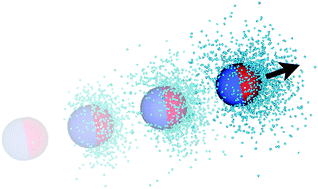A microscopic model for chemically-powered Janus motors†
Abstract
Very small synthetic motors that make use of chemical reactions to propel themselves in solution hold promise for new applications in the development of new materials, science and medicine. The prospect of such potential applications, along with the fact that systems with many motors or active elements display interesting cooperative phenomena of fundamental interest, has made the study of synthetic motors an active research area. Janus motors, comprising catalytic and noncatalytic hemispheres, figure prominently in experimental and theoretical studies of these systems. While continuum models of Janus motor systems are often used to describe motor dynamics, microscopic models that are able to account for intermolecular interactions, many-body concentration gradients, fluid flows and thermal fluctuations provide a way to explore the dynamical behavior of these complex out-of-equilibrium systems that does not rely on approximations that are often made in continuum theories. The analysis of microscopic models from first principles provides a foundation from which the range of validity and limitations of approximate theories of the dynamics may be assessed. In this paper, a microscopic model for the diffusiophoretic propulsion of Janus motors, where motor interactions with the environment occur only through hard collisions, is constructed, analyzed and compared to theoretical predictions. Microscopic simulations of both single-motor and many-motor systems are carried out to illustrate the results.


 Please wait while we load your content...
Please wait while we load your content...